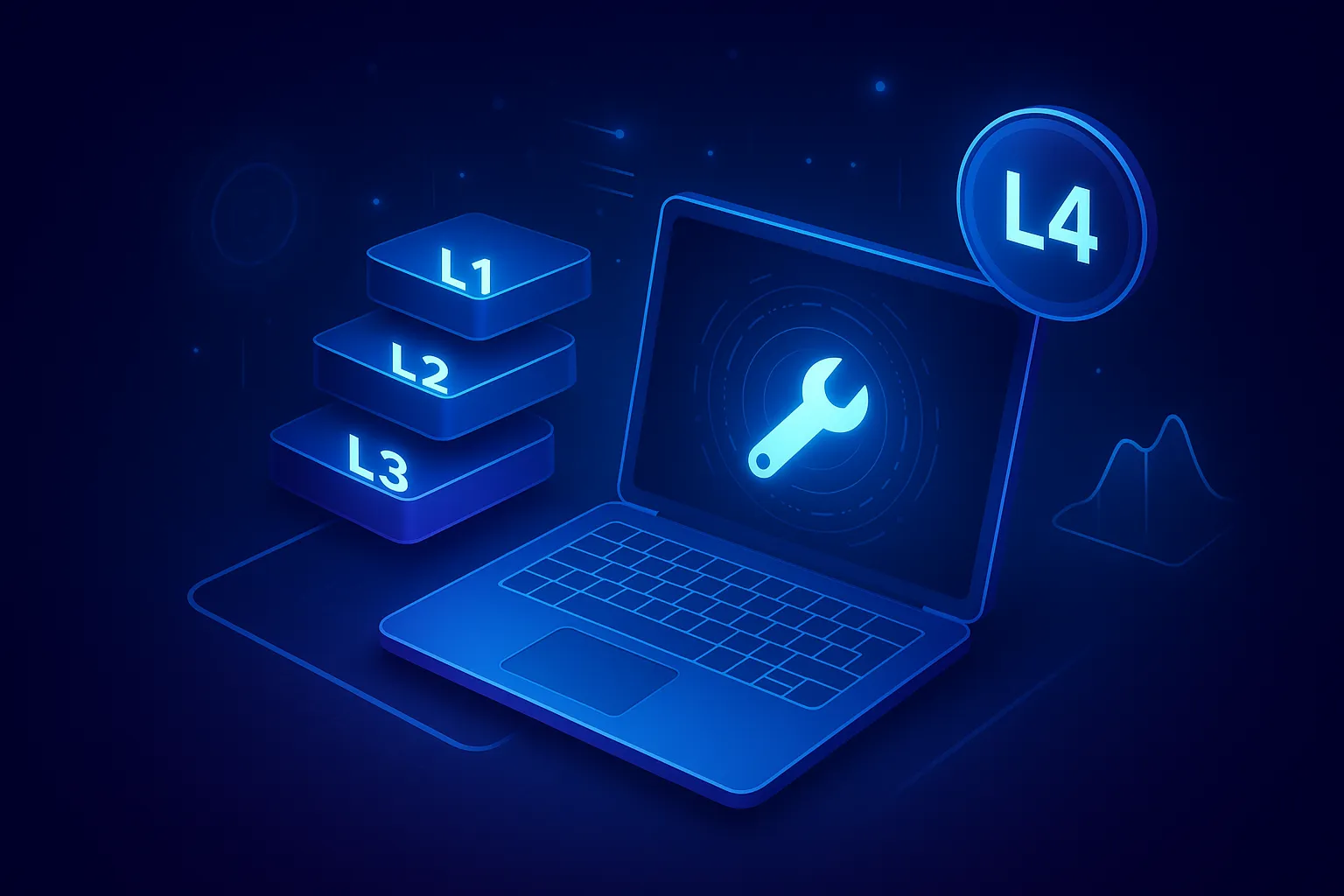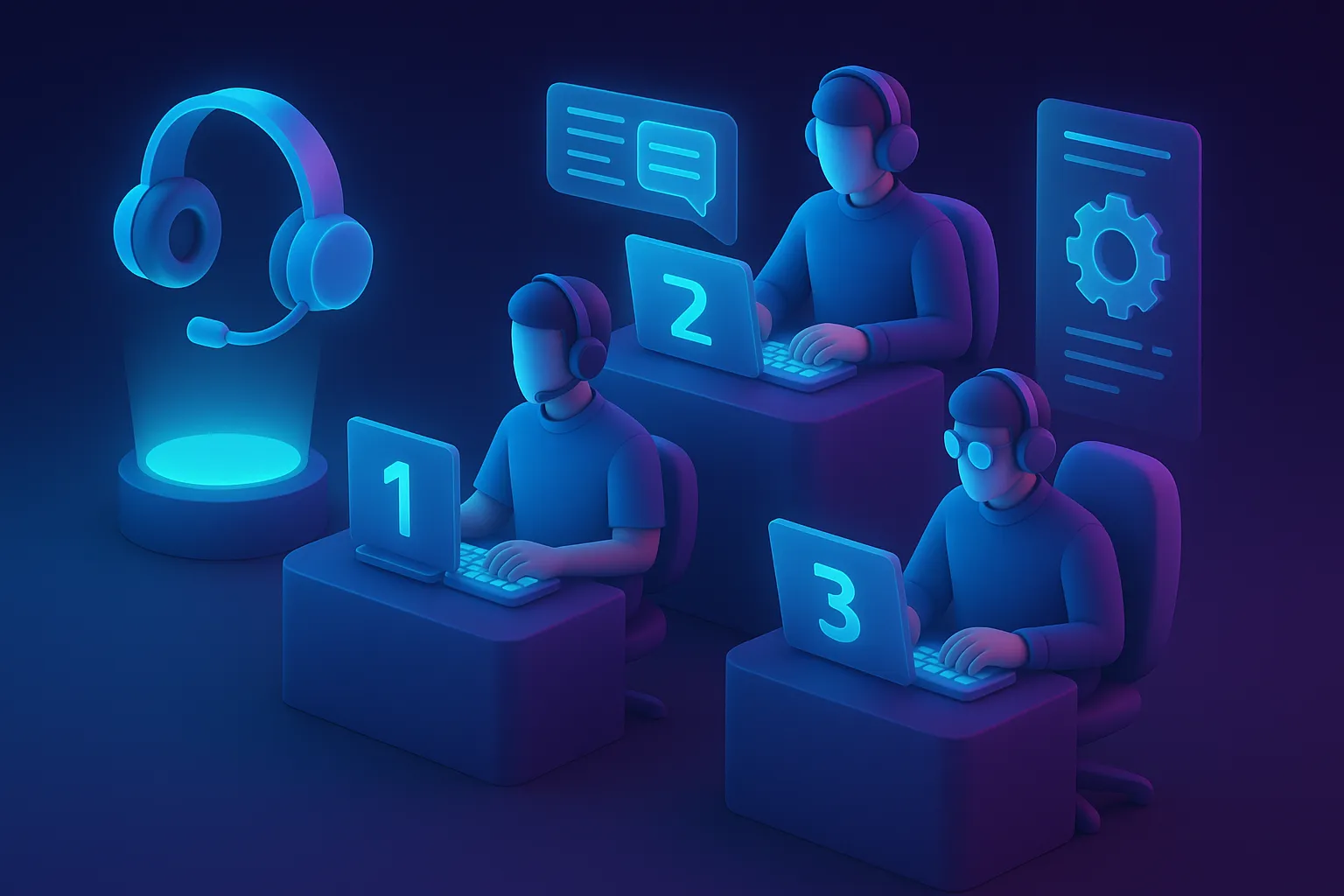August 20, 2025
August 20, 2025

When a technical glitch strikes, the speed and accuracy of your IT team can make the difference between a brief interruption and hours of lost productivity. Behind that efficiency lies a tiered IT support level structure L0, L1, L2, L3, and sometimes L4, each designed to handle specific types of problems with the right expertise. From self-service portals at the most basic computer level to specialized engineering teams tackling the toughest issues, understanding how these layers work together can transform the way your organization manages technology challenges.
Information Technology (IT) support plays a critical role in keeping modern organizations running smoothly. It ensures that employees can access the systems, applications, and devices they need without disruption, and it resolves issues before they escalate into costly downtime. A well-structured IT support framework allows businesses to maintain high productivity, protect data security, and adapt quickly to changes in technology.
One of the most effective ways to organize IT support is by implementing a tiered IT support level system. Each level whether L0, L1, L2, L3, or beyond handles problems that match its scope and expertise. This approach not only streamlines workflows but also ensures that the right people are working on the right issues at the right time.
For example, basic troubleshooting may be handled at an entry-level computer level, while complex system failures are escalated to expert engineers or external vendors.
Beyond problem-solving, IT support acts as a bridge between technology and people. It translates technical challenges into actionable solutions, supports strategic business goals, and drives continuous improvement in system performance.
By clearly defining responsibilities within each IT support level, organizations can deliver faster resolutions, optimize resources, and build user trust, turning IT from a reactive service into a strategic advantage.
A tiered model is the backbone of a reliable help desk: it maps problems to the people best equipped to solve them, reduces wasted effort, and speeds up recovery. Below is a clear, practical breakdown of Levels 0 - 4 so you can see what each IT support level does, what skills and tools it needs, and when an issue should move up the chain.

Before a help desk agent ever gets involved, many organizations empower users to solve their own problems through Level 0 support often called self-service. This is the most cost-effective tier in the IT support level hierarchy, because it handles high-volume, low-complexity requests without consuming technician time.
At L0, users access tools like searchable knowledge bases, FAQ libraries, step-by-step guides, “how-to” videos, service catalogs, or even AI-driven chatbots. These resources are designed to answer common questions: resetting passwords, connecting to Wi-Fi, installing approved software quickly and without waiting in a queue.
Well-structured self-service content should be written in plain language, visually supported with screenshots or short clips, and searchable so users can find answers in seconds.
The true value of L0 lies in its ability to prevent ticket escalation altogether, freeing higher computer levels of support to focus on complex, business-critical issues. When users can resolve their own problems, satisfaction rises, downtime drops, and the entire IT ecosystem becomes more efficient.
Still, L0 works best as part of a seamless escalation path, if self-service can’t resolve the issue, the process should flow smoothly into L1 for human assistance.
When self-service isn’t enough, the next stop in the IT support level chain is Level 1: the frontline support team. These are the first human responders to a user’s problem, acting as both troubleshooters and gatekeepers for more complex escalations.
%20%20Frontline%20Support.webp)
L1 technicians handle common, well-defined issues that can usually be resolved within a single interaction. This includes password resets, account unlocks, printer or network connection problems, basic software installation, and standard configuration changes. They work from detailed runbooks, scripts, and knowledge base articles, aiming for a high First Contact Resolution (FCR) rate so that users can get back to work without delay.
A strong L1 team doesn’t just solve problems, they also triage effectively. By asking the right questions and documenting symptoms in the ticketing system, they gather critical context for L2 if escalation becomes necessary. L1 agents are skilled communicators, balancing technical ability with patience and empathy, ensuring users feel heard and supported.
In short, Level 1 serves as the bridge between quick fixes at the basic computer level and the deeper technical expertise found at L2. When issues exceed their scope, requiring specialized tools, elevated permissions, or in-depth investigation, L1 passes the baton, ensuring the user’s journey through the support tiers remains smooth and frustration-free.
Level 2 is where troubleshooting goes deeper. When an issue proves too complex for L1 to resolve, it moves to L2, the IT support level staffed by more technically skilled specialists. These technicians are often system administrators, network engineers, or application support experts with advanced knowledge of infrastructure, operating systems, and enterprise applications.
%20%20Technical%20Support.webp)
L2 responsibilities include analyzing system logs, diagnosing hardware failures, investigating recurring performance problems, fixing software bugs that don’t require code changes, and handling advanced configuration tasks. They have elevated access rights, use specialized diagnostic tools, and can replicate issues in controlled environments to pinpoint root causes.
Unlike L1, which follows predefined scripts, L2 work is often less predictable. It requires critical thinking, a deeper understanding of system architecture, and the ability to connect symptoms with underlying technical factors. In many cases, L2 not only resolves the issue but also creates or updates documentation so that L1 can handle similar problems in the future, effectively raising the baseline capability of the lower computer levels.
When a problem demands code modifications, architectural redesign, or the expertise of the original product engineers, L2 escalates to L3. But when they can resolve an issue, L2 ensures the fix is thorough, stable, and ready to prevent repeat disruptions, keeping the business running without further escalation.
When a problem goes beyond the scope of L2, it lands in Level 3, the highest internal IT support level within most organizations. This is the domain of expert engineers, architects, and product development teams, who have the deepest understanding of the systems, code, and infrastructure in play.
%20%20Expert%20%20Engineering%20Support.webp)
L3 handles the toughest, most complex issues, often requiring changes to source code, in-depth architectural reviews, or collaboration with external vendors. They’re not just problem solvers; they’re problem preventers, delivering long-term fixes that improve overall system resilience.
Typical L3 responsibilities include:
Key characteristics of L3 support:
In the broader computer level hierarchy, L3 is the last line of internal defense before engaging external vendors (L4). By delivering permanent solutions rather than temporary patches, L3 ensures the IT environment evolves to meet future demands, turning technical crises into opportunities for improvement.
Some problems can’t be solved in-house, no matter how skilled your internal team is. Level 4 is the IT support level where responsibility shifts to external parties: hardware manufacturers, software vendors, cloud providers, or specialized third-party consultants.
These external experts possess proprietary knowledge, source materials, and diagnostic tools that internal teams simply don’t have. They can access hardware schematics, proprietary firmware, and closed-source code, making them the only ones capable of fixing certain issues.
Common L4 activities include:
Engaging L4 should be a structured process, internal L3 teams prepare detailed logs, reproduction steps, and test results before escalation. Once the vendor provides a solution, L3 and L2 handle implementation, while L1 and L0 ensure the resolution is communicated to end users.
In short, Level 4 represents the final escalation point in the IT support level framework, closing the loop between internal expertise and the external resources needed to maintain a healthy, reliable IT environment.
Knowing the IT support levels is one thing, making them work in real life is another. Successful implementation requires clear workflows, documented responsibilities, and a culture of seamless communication across all computer levels. The goal is to ensure that every issue moves through the right hands, at the right time, with no unnecessary delays.
Key steps for effective implementation:
1. Define Responsibilities Clearly
2. Implement a Ticketing System
3. Standardize Escalation Criteria
4. Ensure Proper Handoffs
5. Feedback Loops for Improvement
Benefits of a structured escalation process:
A well-designed escalation process turns the IT support level model into a living, adaptive system, one that not only resolves problems efficiently but also evolves with the organization’s needs.
Conclusion
The tiered IT support level model isn’t just a technical framework, it’s a strategy for delivering smarter, faster, and more reliable assistance. By defining clear roles from self-service at Level 0 to specialized vendor support at Level 4, organizations can resolve issues at the right computer level, minimize downtime, and make the best use of both human and technological resources.
When implemented effectively, this model creates a smooth escalation path, empowers frontline teams, and ensures that expert resources are reserved for the challenges that truly require them. More than that, it transforms IT from a reactive problem-fixer into a proactive business enabler.